Premature Labor and the New-Born Child
Premature Labor and the New-Born Child
By Henry W. Bettman, M.D.,
Cincinnati, Ohio.
American Journal of Obstetrics and Diseases of Women and Children 25:315-328, 1892.
Paper read before the Society of American Physicians in Berlin, July 30th, 1891.
Among all the complex phenomena of life none is more interesting than that wonderful series of changes in the infant which accompanies its birth.
The mother, whose circulatory and respiratory capacity has for many weeks been tested to the utmost, finally, through some unknown mechanism, rebels against the burden laid upon her and casts off the load. There enters into the world an independent living being.
Life has been defined as adaptation to surroundings. And the new being, without special preparation and in the course of a few hours, is precipitated into surroundings whose needs and conditions of life differ entirely in number and nature from those from which it has just emerged. No crisis of life is equal to this birth.
Suddenly deprived of the supply of oxygen circulating in the maternal placenta, it is, at one stroke, thrust upon its own resources for the purification of its own blood, and for the first time the nerve cells in the medulla are roused to action, the chest moves, and the lungs expand to receive the outside air.
Its old system of circulation suddenly becomes inadequate to meet the demands of its new life, and the expanding lungs call for their supply of blood. The placental circulation is to be exchanged for a no less complicated pulmonary one. Almost as if by magic the ductus Botalli collapses, a moment later the foramen ovale becomes extinct, and the new requirements are met.
Thus the child adapts itself to new conditions. The crisis is passed and it is enabled to continue its existence.
But the real battle for life is yet to be fought. Separation from the placenta means not only a loss of oxygen, but also a loss of food, and whatever the nourishment the child is now to supply to the cells of its body, it must prepare for them itself out of the raw material sucked from the maternal breast.
Robbed of its oxygen and of its food, it is at the same time deprived of its shelter. The warmth of the uterus is exchanged for the comparative coldness of the outside air. From a temperature of 100° F. it is thrust into an atmosphere of 68° or 70° F., and thus at once put upon its own resources for the maintenance of its body heat.
Heat, food, oxygen, the three necessities of life, and for these the new-born child is henceforth to depend wholly upon itself.
As in all struggles, so here, the outcome depends largely upon the preparation. If the child comes well armed, which circulatory, respiratory, and digestive apparatus normally developed, the chances of its survival are strong. If it is puny, with shrivelled skin, ushered into the world before its time, the chances of life are correspondingly small.
The average weight of children at birth, and the fluctuations in weight during the first week of life, have been subjects of considerable interest to medical writers, and observations are numerous and give fairly uniform results. To add a contribution to the subject from an American standpoint, I, with the aid of my associates, took occasion, during the winter of 1890-91, to weigh all the new-born infants in the Cincinnati Hospital, and to continue the weighing daily for two to three weeks after birth.
By these means I was able to collect seventy-five cases of healthy children, breast-fed by healthy mothers, and thus gain an estimate not only of the average weight at birth, but also of the normal fluctuations in weight during the first few weeks of life. The results agree in the main with those of European authors, but differ in a few points not unessential.
The average weight of all the infants was seven pounds five ounces (3,324 grains), of those of the primiparae seven pounds six ounces. This greater weight on the part of the infants of primiparae is opposed to the general law that the weight of children increases with the number of gestations of the mother. It agrees with the law in so far that the average weight of the ten whose mothers had borne more than three children was seven pounds eight and three-tenth ounces.
The processes immediately following birth are not without effect upon the weight of the infant. Urine and meconium are soon voided, and the vernix caseosa is removed before or during the first bath. The diminution in weight occasioned by these losses is, as a rule, not regained by the infant until several days after birth.
Charts Nos. 1 and 2 may be taken as types of the ordinary fluctuations in weight during the first few weeks, i.e., a loss during the first few days, then a gradual but constant gain. The primary loss may be so severe that it may seriously affect the development of the infant during its first months of life. Budin [1] reports a case where the original loss was 13.3 ounces (380 grammes) in two days; another where during the first twenty-four hours the infant lost 17.2 ounces (490 grammes)!
Chart No. 3 illustrates a case where the original loss was greater still, amounting to eighteen ounces during the first twenty-four hours and twenty-eight ounces during the first nine days. In this case the excessive loss was due to the enormous amount of vernix with which the child was covered, and which was included in the original weight. Not always, however, does the infant lose during the first few days — the vast majority of German writers to the contrary notwithstanding — and the birth weight may remain the lowest. Bouchaud, in fifty-four cases, found no primary loss in five. Of my seventy-five infants, seven, or nearly ten per cent, show no initial loss. Budin [1] acknowledges also that there may be no initial loss, and tries to explain the fact by supposing that the infants were weighed originally after emptying their bladders and rectums, and that their mothers were multiparae whose breasts were full of milk. As three of my seven cases are primiparae, the hypothesis of Budin scarcely suffices.
Chart No. 4 illustrates one of the cases and shows remarkable development on the part of the child, similar in many respects to that of the lower animals (cats, dogs, rabbits, pigs); for in the lower animals [2] (except the guinea-pig [3] [4]) the young begin to gain almost from birth and double their original weights inside of a week or two. The new-born rabbit, in fact, usually doubles its weight in four or five days.
The laws which prevail may be summed up in a few words. The birth weight diminishes during the first two or three days, then begins to increase at the rate of one to three ounces daily. Some writers of repute, and among them no less a one than Winckel, try to associate in time the first increase of weight with the falling off of the umbilical remnant; but the relation is wholly fanciful in my mind, and denied by the large majority of observers. The heavier the child at birth, the less it is likely to lose. Thus boys lose less than girls and gain more rapidly.
Writers are not agreed as to the duration of the initial loss, estimates ranging from two to five days; all uniting in giving the average in ounces as five and a half to seven, though, as shown above, this may vary within wide limits, becoming excessive on the one hand or absent entirely on the other.
In my own cases the average loss is almost exactly six ounces, the duration two and a half days. But averages in this, as in other matters, are somewhat misleading, and we naturally expect a healthy child to gain during the third day. Toward the end of the first week the original weight is regained.
In my seventy-five cases, at the end of the first week there is an average gain of one and two-third ounces, and this is increased at the end of the second week to 5.9 ounces. From this time on gain should be uninterrupted. At the end of the first month weight is increased by one-third, doubled in six months, and tripled in a year (Henoch).
So much for figures and details. It is scarcely necessary at this day to insist on the regular and systematic weighing of infants. Where the sufficiency of the mother’s secretion is in question, weighing the infant immediately before and immediately after nursing establishes the amount of nourishment obtained. When the infant appears not to be gaining strength, recourse to the scales at once establishes the fact, and a wet-nurse or artificial feeding can be employed before the strength of the infant is markedly vitiated. I may say without exaggeration that the scales are as essential to the correct estimation of the progress of an infant as the thermometer in the estimation of a case of typhoid fever. Both can be dispensed with and the physician rely on his own unaided judgment. With them he has in his possession a most perfect and unfailing adjuvant to his own powers.
Chart No. 5 shows clearly the direct relation between the health of the infant and the method of feeding, and shows the value of the scales in suggesting a timely change of diet.
But during the last few years special interest has centred about the premature or immature infants. The present activity in searching out new remedies (a reaction against the nihilism of forty years ago) has found expression also in the care bestowed upon the unfortunate infant born before its time; and no efforts have been spared to surround the weakling with all those conditions necessary to bridge it over to its first few and precarious weeks.
So in 1866 Credé established his double-walled Warme-Wänne in the Maternity at Leipzig; at Moscow and St. Petersburg similar methods were adopted, and in 1880 Tarnier introduced his incubator, or couveuse, into the regular practice of the Maternité of Paris. And these devices have done much to change the aspect not only of the rearing of the premature child, but of other grave questions immediately depending upon the success of such efforts. At first sight there seems to be no very close relation between the incubator for premature infants on one side, and Cesarean section, craniotomy, induction of premature labor on the other; but the connection is radical, and during the past twenty years has aroused the attention of all obstetricians.
In fact, it was the uniform fatality attending the Cesarean section in England which first led Cooper, in the latter half of the eighteenth century, to induce premature labor in a case of contracted pelvis. From that time up to 1869 the procedure was applauded and practised by many; condemned and repudiated by others, its position was never clearly established.
In 1870 Spiegelberg [5] attempted by one effort to overthrow the reputation of the induction of premature labor as a justifiable obstetrical procedure for contracted pelvis. He published a record of all cases of contracted pelvis delivered in his clinic between 1865 and 1869, to the number of 307. Of the cases left to Nature, 2.4 per cent died and 15.7 per cent of their infants. Of those in whom premature labor was induced, 11.2 per cent died and 61.9 per cent of their infants.
But conclusive as these statistics appear at first sight, they did not long remain unchallenged, and Prof. Dohrn, then at Marburg, appeared in 1874 as a strong supporter of premature delivery [6]. He repudiated Spiegelberg’s figures as unscientific, there being no means of comparing the two classes of cases — i.e., the spontaneously and artificially delivered ones — and established statistics of his own in their stead. He showed that of 18 women who, with contracted pelves, had previously borne 29 children spontaneously, 45 per cent had a severe puerperium and 90 per cent of their children died; while in 18 premature deliveries, performed on the same women only, 39 per cent had a severe puerperium, while 56 per cent of the children were saved.
Dohrn during the last International Congress has extended these figures and brought them into the antiseptic period of midwifery. From figures of Wyder, Kehrer [7], Leopold, and himself he has collected 271 cases of premature delivery for contracted pelvis in which the mothers had also been delivered spontaneously at some previous time. Of the mothers 16, or 5.9 per cent, died, while 60 per cent of the children were saved. Of the children delivered from the same mothers at term, only 29 per cent were saved. The maternal mortality of 5.9 per cent seems very high, but the estimate is scarcely justified by figures given by other authors, and in the hands of Winckel, Sabarth, Häcker, Fehling, Budin, Tarnier, the maternal mortality is practically nil!
A year ago Ahlfeld [8] published in the Centralblatt für Gynäkologie a report of 111 cases of induction of premature labor for contracted pelvis performed under his direction; and of these 111 mothers, only 1 died, and she as the result of excessive pressure. So with careful asepsis we can expect the mortality attending this procedure to disappear entirely, as it has already in the hands of some operators.
Turning our attention from the mothers to the children, we find that what asepsis has done for the one the various incubators have done for the other. Even Dohrn in 1874 says that “no practitioner would wilfully induce premature labor as early as the twenty-eighth week with any idea of saving the child,” and adds, with calm self-assurance, that such reported cases, when successful, are probably mistakes in counting the duration of pregnancy! But in 1888 Credé [9] published a list of all premature infants born in the Leipzig Klinik since the introduction of his Warm-Wänne in 1866. During these twenty-two years the mortality of children born at term was 5 1/2 per cent. The mortality of children born prematurely was 18 per cent. Excluding the children who at birth weighed less than three pounds five ounces, of 653 premature children 85 per cent were saved.
But the results obtained by Tarnier in the Maternité of Paris are better, especially for the very weak. Of children born at eight and one-half months, 95 per cent survived; of those born at eight months, 85.7 per cent survived; of those born at seven months, 63 per cent survived; of those born at six months, 30 per cent survived. So in the light of these figures Prof. Dohrn must retract his statement; must acknowledge that considerable hope gathers about the child born at twenty-eight weeks (as 30 to 63 per cent of them survive, which only thirty years ago was as good — or a better — result than was obtained for the general average of premature children).
Budin, in a clinical lecture in December, 1887, called attention to two currents flowing in opposite directions on the subject of contracted pelvis — the German current directed to Cesarean section, that of the French directed to induction of premature labor. With the best modern methods the mortality of Cesarean section has been wonderfully reduced. The best statistics I can find are those published by Caruso [10], of Naples, in June, 1888. One hundred and thirteen cases were collected of Cesarean section, performed by the modern conservative methods, for contracted pelvis. Excluding two fatal cases in which the operation was contra-indicated, the mortality is 18.6 per cent. Even Leopold’s [11] mortality out of 23 cases is 8.6 per cent, and ordinary operators cannot hope to attain such results.
If, then, we were to contrast the relative advantages and disadvantages of the two procedures, we would have: On the side of Cesarean section 5 mothers out of 27 die, while 90 to 95 per cent of the children are saved. Not any of the mothers who survive the operation can be called cured, as the dangers due to the uterine suture are not by any means slight, and have been suppressed in the past rather than exaggerated. On the side of premature delivery nearly all the mothers are saved, while 30 to 95 per cent of the infants survive, according to the time of delivery.
Nor must you suppose than an incubator is beyond the reach of physicians in private or even country practice, or that special skill and experience are required in rearing the prematurely born. The incubator used in the Cincinnati Hospital was built for Dr. W. H. Taylor on Tarnier’s model at a cost of ten dollars. The rules for the care of the infant are simple. The temperature in the incubator should be kept constant at 32° C. (but may vary between 30° and 35° C.). The infant should suckle, if possible, otherwise it should be fed with a spoon or medicine dropper or stomach tube. It should be swaddled in soft flannel, as the temperature under the garments is 2° to 3° C. higher than without, and as the child is thus protected against possible fluctuations in temperature due to carelessness or accident. Our experience with poorly developed infants in Cincinnati Hospital during the winter of 1890-91 was not large, embracing only 23 infants who at birth or shortly afterward weighed less than six pounds. The results show, however, how good a chance for survival even the weaklings have under modern careful attention:
- 10 infants weighed between 6 and 5 lbs. All survived.
- 8 infants weighed between 5 and 4 lbs. 7 survived.
- 4 infants weighed between 4 and 3 lbs. 2 survived.
- 1 weighed 2 14/16 lbs at birth and lived 11 days.
Thus of 23 infants 19 survived, or 82.6 per cent. Of those between six and four pounds, 94 1/2 per cent were saved. (See Charts No. 6 and 7 as types.)
This paper would not be complete without reference to an entirely new solution to the question of moderately contracted pelvis proposed by L. Prochownick [12], of Hamburg, in August, 1889. Prochownick tried the novel experiment of stunting the growth of the fetus in utero by starving the mother, or, rather, placing the mother on the ordinary diet for diabetes. His first patient had been delivered of four children: two prematurely, one by version, one by perforation. All the infants perished. Toward the close of the fifth pregnancy the patient was placed on the strict diet, and was delivered at term of a healthy infant weighing five pounds three ounces, with adipose layer practically wanting, and with very movable skull bones. The infant developed rapidly and normally. Encouraged by his success, he repeated the experiment in two similar cases, and in both the infants born were thin, had movable skull bones, and thrived perfectly. Thus three mothers who had borne eight dead children were enabled by these means to rear living offspring. Prochownick has found imitators, and in March, 1890, A. v. Brehm [13] reported a fourth successful case in the St. Petersburg Medicinishe Wochenschrift.
This departure of Prochownick is so novel, is based on such rational physiology, and has been so signally successful that it merits not only the general attention of the obstetric world, but also general imitation in appropriate cases.
Figures
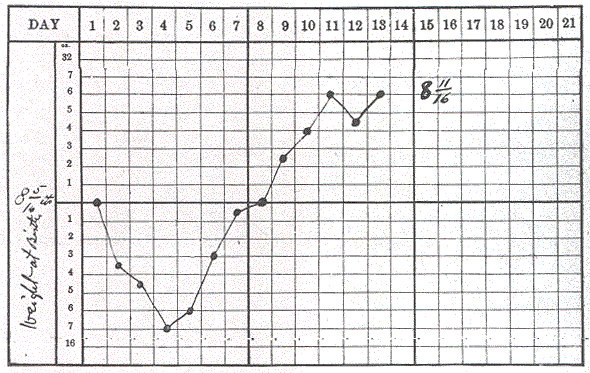
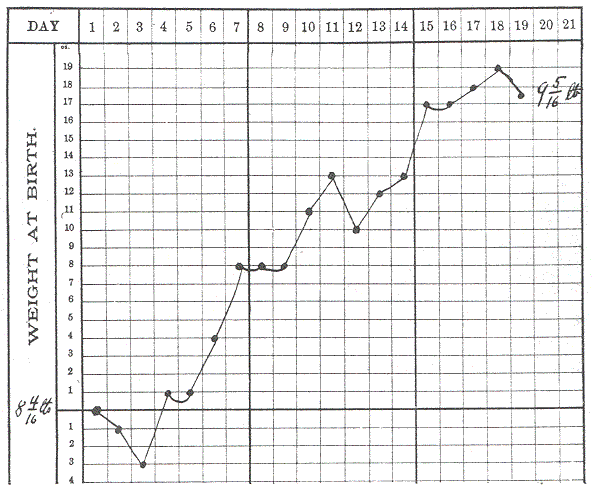
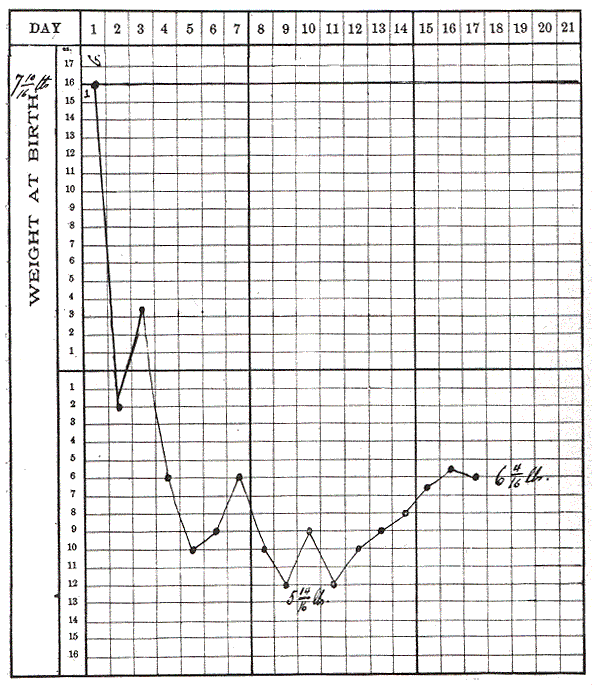

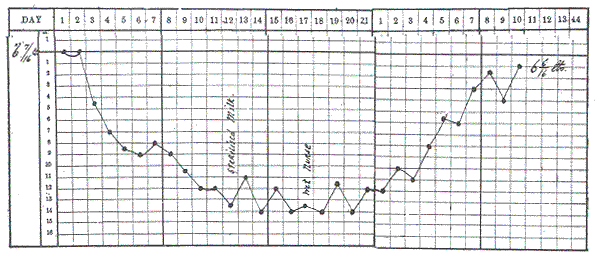
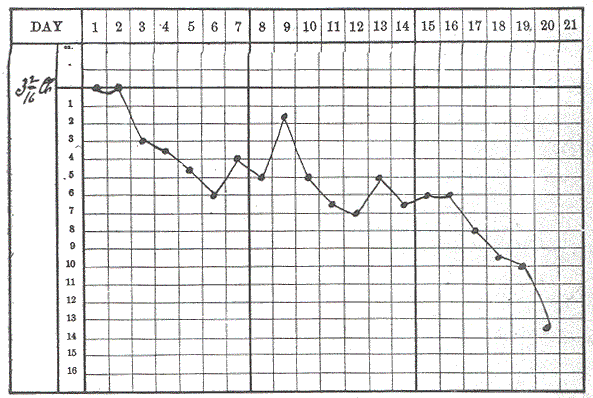
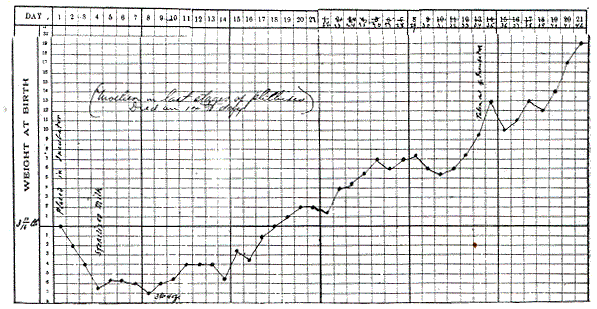
Bibliography
[1] Budin: Leçons de Clinique Obstetricale, Paris, 1889, p. 278.
[2] F. A. Kehrer: Ueber die Ursachen der Gewichtsveränderungen der Neugeborenen. Archiv für Gynäk., 1870. S. 124-145.
[3] G. Edlefsen: Beitrag zur Kenntniss der Gewichtsveränderungen neugeborener Säugethiere. Archiv für Gynäk., 1870, iii., S. 403-405.
[4] Gregory: Ueber die Gewichtsverhältnisse der Neugeborenen. Archiv für Gynäk., ii., 1871, S. 48 et seq.
[5] Spiegelberg: Ueber den Werth der Künstlichen Frühgeburt. Archiv für Gynäk., 1870., i., S. 1 et seq.
[6] Dohrn: Ueber die künstliche Frühgeburt bei engem Becken. Volkmann Samml., 94. Also Archiv für Gynäk., 1875; Proceedings of Tenth International Congress.
[7] F. A. Kerher: Die Erste Kindernährung. Volkmann Samml., No. 70.
[8] J. Ahlfeld: 118 Fälle der künstlichen Frühgeburt. Centralblatt für Gynäk., July 26th, 1890.
[9] Credé: Archiv für Gynäk., 1888, S. 128 et seq.
[10] Caruso: Archiv für Gynäk., June, 1888, S. 211 et seq.
[11] Leopold: Der Kaiserschnitt und seine Stellung zur künstlichen Frühgeburt. Stuttgart, 1888.
[12] Prochownick: Ein Versuch zum Ersatz der künstlichen Frühgeburt. Centralblatt für Gynäk., August 17th, 1889.
[13] H. v. Brehm: Ein casuistischer Beitrag zur Umgehung der künstlichen Frühgeburt.
Last Updated on 07/19/24